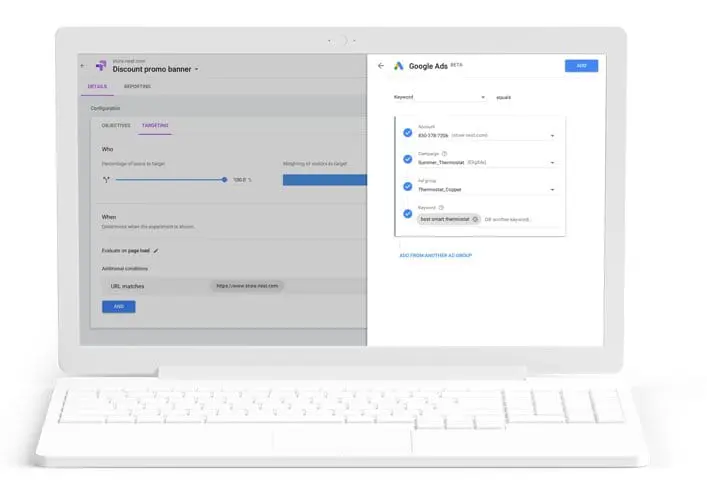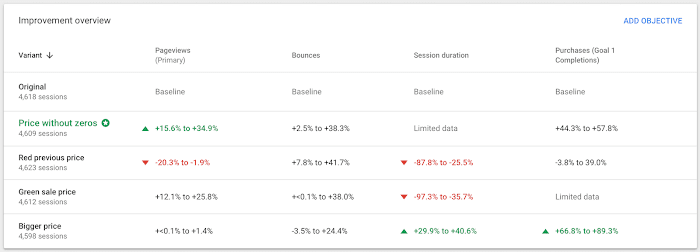Your online presence is the beating heart of all your marking endeavours. Even if your website doesn’t make use of e-commerce, that doesn’t mean that it isn’t a valuable and highly important revenue stream. Your website will, for many new prospects, be their first exposure to your brand and your business. It will represent everything you, and your business, stand for and reflect the values and ideals upon which your brand is built.
The sad truth is, in the digitally-led and highly competitive world of 21st-century commerce, it doesn’t matter how great you are at what you do, how high your standards of customer service or how amazing your products, if nobody knows who or where you are. Think of your website as your shop window. You want it to look so inviting and appealing that all who pass by feeling compelled to push the door open and step inside.
Google Optimize helps to ensure that your window is always clean, sparkling and inviting to ensure a healthy flow of traffic to your website.
What is Google Optimize?
Google Optimize is a free tool created by Google to help owners of SMEs and anyone else whose living is intrinsically tied to their website. It helps users to ensure that their website is running optimally and offers a range of options for testing and experimentation.
It allows you to create and test optimized landing pages for Google Ads, thereby capitalising on paid advertising and helping users to boost their conversion rates. It also allows you to tailor your user experience for different kinds of users, so that you can comprehensively cater to the needs of your future loyal customers. Google Optimize offers a suite of features including;
- Native integration with Google Analytics so you can respond quickly and decisively to analytic data.
- AB Testing.
- Basic URL targeting.
- Geo-targeting.
- Technical targeting (i.e. cookies, Javascript, data layer etc.).
- User behaviour and technology targeting.
- Multivariate testing up to 16 combinations.
- The ability to set up to 3 preconfigured experiment objectives.
- A self-service help centre and community forum where users can find and exchange answers to common problems.
There’s also a paid upgrade called Optimize 360 which has all of the above plus the following;
- Google Analytics-based audience targeting.
- Multivariate testing up to 36 combinations.
- The ability to set up to 10 preconfigured experiment objectives.
- Capacity for over 100 simultaneous experiments.
- Enterprise level support.
Before you make a decision whether Google Optimize is enough to suit your needs, or whether it’s worth your while to spring for Optimize 360, let’s take a look at how to get started on Google Optimize.
Getting started with Google Optimize
If you don’t have a technical background, Google Optimize can seem a little intimidating despite its intuitive interface. One thing many users find themselves thinking is “Where do I start?”. Allow us to take the guesswork out of proceedings for you with these tips on getting started with Google Optimize…
Laying the groundwork
Your first priority should be to install the Optimize tag on your website. There are several different ways you can do this but the most effective way is by using Google Tag Manager. It allows for quick and consistent deployment across every single page in your website, and will lay a strong foundation for adaptability and productivity later down the line.
GTM comes with a built-in tag for Google Optimize, so to get the ball rolling you just need to create a new tag in your account, and specify that you want to use the Google Optimize tag. For easy Google Analytics integration, simply add your Google Analytics ID in the “Tracking ID” box.
Finally, set a trigger to fire on the pages you want to test with Google Optimize (or the whole site if you prefer). Head on over to preview mode to check that your triggers are firing correctly. Then it’s just a case of publishing the tag to your live site. You are now ready to experiment!
Establish the parameters of your experiment
Like any experiment you’ll need clear parameters and performance indicators. What sort of timeline do you want to conduct the experiment over? If you want to test a page near the bottom of your conversion funnel it can take up to a month for clear statistical trends to emerge. Are you happy to wait that long?
Before carrying out a test, it’s also important to know what you’re testing for and what your KPIs will be. Data doesn’t lie… But it can mislead or draw you to erroneous conclusions if you don’t know exactly what you’re looking for. Fortunately Google Optimize allows you to define custom objectives.
Create a test plan
The free version of Google Optimize will only allow you to carry out 3 simultaneous tests so it’s important to go into them with careful planning. A test plan will ensure that you get valuable insights from your tests so that 3 simultaneous tests should be more than enough for your marketing team to go on.
A test plan can be whatever you want it to be, so long as it gives you a direction that everyone can rally towards and a clear idea of how it can help you to answer underlying questions about your business. Does that sound a little too nebulous? Let’s look at a practical example…
Testing PPC landing pages
Let’s look at a business question many entrepreneurs find themselves asking; “Are my PPC landing pages generating sufficient ROI?”. After all, PPC advertising is an expense that marketing departments need to be able to justify. The faster you can see a quantifiable return on your investment, the easier you can rest in the knowledge that the money you spend on PPC is a worthy investment.
The great news is that using Optimize for PPC landers might just be the fastest and most decisive way to see a clearly quantifiable ROI from A/B testing. Landing pages tend to be high-converting pages with a single clear, easily measurable goal… To convert! You don’t need to worry about inconsequential data like scroll depth or time on page for pages of this nature. You can use a variety of tests to create the perfect formula for a high-converting landing page. Try experimenting with different form lengths, different wordings on your CTAs, different titles, copy and images to determine which pages resonate most strongly with your audience.
Once you’ve familiarised yourself with Google Optimize, it can become a powerful and multifaceted tool. And best of all… It’s completely free!
Summary
Google Optimise takes Google Analytics to another level. Not only can you analyse your user page experience, you can also test hypothesis and improve it.


